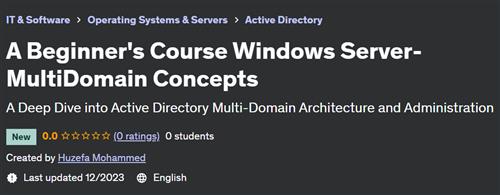 Free Download A Beginner's Course Windows Server–MultiDomain Concepts
Free Download A Beginner's Course Windows Server–MultiDomain ConceptsDuration: 16 h48m | Video: .MP4, 1920x1080 30 fps | Audio: AAC, 48 kHz, 2ch | Size: 11 GB
Genre: eLearning | Language: English
A Deep Dive into Active Directory Multi-Domain Architecture and Administration
What you'll learn
In This Course you will learn how to install and Configure Windows Active Directory with Multi-Domain Environment.
You will learn how to configure Trust Relationships in the course
You will also learn how to manage FSMO Roles Transfer and Seizeing in multi-Domains
You will learn how replication happens between domains and Domain Controllers.
System Administrators and Dekstop Admins can use this course to improve your skills.
Requirements
No Specific skills require. If you have any Desktop Support experience, thats good.
Have some computer knowledge, thats enough.
Description
Active Directory (AD) Multi-Domain Concepts refer to the architectural and organizational elements involved in deploying and managing multiple domains within an Active Directory forest. Here's a more detailed description of these concepts
Forest
Definition: A forest is the top-level structure in Active Directory that consists of one or more domains. It serves as the security boundary and administrative boundary for objects within the entire structure.
Significance: A forest allows the sharing of a common schema, configuration, and global catalog across all domains within it.
Domain
Definition: A domain is a logical grouping of network objects, such as users, computers, and devices, that share a common security policy and database.
Significance: Each domain has its own unique domain name and security policies but shares the same schema and global catalog with other domains in the forest.
Tree
Definition: A tree is a hierarchical arrangement of domains within a forest. The first domain created in a forest is the root domain, and additional domains created subsequently form a tree structure.
Significance: Domains within a tree share a contiguous DNS namespace and are connected by trust relationships.
Trust Relationships
Definition: Trust relationships establish secure communication channels between domains, allowing users in one domain to access resources in another domain.
Significance: Trusts can be one-way or two-way, and they play a crucial role in enabling cross-domain authentication and resource access.
Global Catalog (GC)
Definition: The global catalog is a distributed data repository that contains a partial replica of all objects in the entire forest.
Significance: The global catalog facilitates faster searches for objects across domains and is essential for certain authentication and authorization processes.
Multi-Domain Trees and Forests
Definition: A multi-domain tree involves a collection of domains with a contiguous DNS namespace forming a tree structure within a forest.
Significance: Multi-domain forests consist of multiple trees, each with its own unique DNS namespace, connected by trust relationships.
Schema
Definition: The schema defines the structure and attributes of objects stored in the Active Directory database.
Significance: The schema is common across all domains within a forest, ensuring consistency in the definition of objects and their properties.
Understanding and effectively managing these concepts is crucial for designing a scalable, secure, and well-organized Active Directory infrastructure that meets the requirements of complex enterprise environments with multiple domains.
Who this course is for
Freshers who are willing to know about Active Directory in-depth.
System Administrators and Dekstop Admins can use this course to improve your skills.
Homepage
https://www.udemy.com/course/a-beginners-course-windows-server-multidomain-concepts/
Buy Premium From My Links To Get Resumable Support,Max Speed & Support Me
A Beginner's Course Windows Server–MultiDomain Concepts Torrent Download , A Beginner's Course Windows Server–MultiDomain ConceptsWatch Free Online , A Beginner's Course Windows Server–MultiDomain Concepts Download Online
Comments

